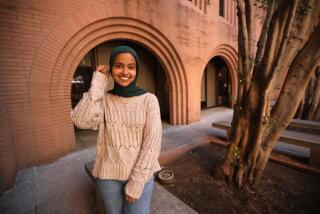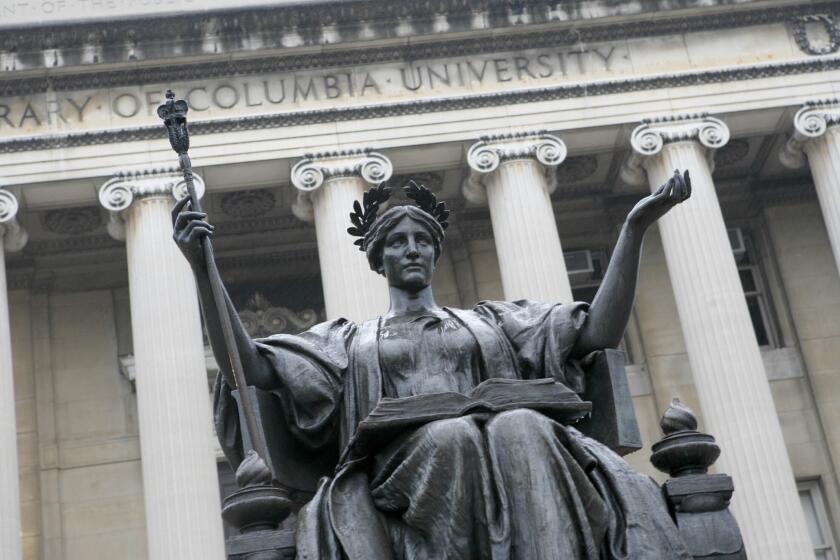How UC is rigging the admissions process
Ever since California voters banned the use of racial preferences in government and education in 1996, the University of California has tried to engineer admissions systems that would replicate the effect of explicit racial quotas while appearing color-blind.
To some observers, the legality of those efforts has long been suspect, but proof of wrongdoing has been hard to come by. Now a professor who sat on UCLA’s committee on undergraduate admissions is charging that the school is deliberately taking race into account when deciding which students to admit. The university has refused to give him access to the data to test his claim, prompting the professor -- political science faculty member Tim Groseclose -- to resign from the school’s admissions oversight committee in protest.
UCLA’s stonewalling is misguided and futile. Though the University of California has always jealously guarded information on its students’ qualifications and its admissions procedures, enough details have come out over the last 10 years to suggest that race remains a factor in many parts of the system. More important, hard evidence is accumulating that enrolling students in a college for which they are academically unprepared does them a disservice.
The story begins with the passage of Proposition 209, the 1996 anti-quota ballot initiative, which reduced the number of African Americans admitted to campuses across the state and sent UC officials into crisis mode. They began implementing a series of admissions changes intended to bring underqualified blacks and Latinos back to the system’s most demanding campuses.
They tried a preference scheme for low-income students, but it backfired when it boosted the number of Eastern European and Vietnamese admissions -- not the sort of “diversity” the university had in mind. Administrators cut the low-income preferences in half and went back to the drawing board.
The subsequent admissions gambits, which continue to be rolled out to this day, are intended to increase “diversity” without running afoul of the law. Whether they have succeeded in substituting other factors for race in a permissible manner, or whether they are illegally seeking to pervert the requirements of the law, will probably be decided, in the end, in court.
Berkeley’s Boalt law school, for example, reduced the role of academic qualifications in ranking students; the resulting disparities between minorities and whites at the school were enormous. In 2002, Boalt admitted only 5% of white students in a low academic rank, but it admitted 75% of black applicants in the same range.
At UCLA, from 1998 to 2001, black applicants were 3.6 times as likely to be admitted to its undergraduate college as whites, and Latinos 1.8 times as likely, even after controlling for economic status and school ranking, according to an unpublished study by statistician Richard Berk.
The most powerful tool that the University of California has come up with to engineer such outcomes is something it calls “comprehensive review,” which, as the president’s office delicately put it in 2003, “broadens the conception of merit.” Under comprehensive review, a student’s academic qualifications are boosted or demoted according to various factors, including his or her life situation -- whether he or she lives in a high-crime neighborhood, has been a shooting victim, is a single parent or comes from a single-parent home, for example.
Even with such a relativist take on academic credentials, UCLA still faced a dearth of qualified black students. In 2005, under enormous political pressure to increase the low black enrollment at UCLA, acting Chancellor Norman Abrams all but demanded that the faculty adopt a more radical version of comprehensive review -- “holistic” review -- which deconstructs the idea of objective academic merit even further.
UCLA’s associate vice provost for student diversity also directed the admissions committee to increase the number of blacks who read and rate student applications, resulting in a 25% black representation among readers, more than three times the ratio in California’s population.
Abrams had assured the black community that UCLA would increase its black admissions rate, and sure enough, holistic review did just that. For 2006-07, the last year under the old system, UCLA admitted 250 black students; the next year, it admitted 407.
The average combined SAT score for black admits dropped 45 points to a level about 300 points lower than the average among white and Asian admissions, according to a report by Groseclose. Blacks’ chances of admission rose from 11.5% to 16.5%, while that of Vietnamese students, who tend to come from poorer households, dropped from 28.6% to 21.4%.
Groseclose wanted to evaluate whether a student’s mention of his race on his application essay affected his chance of admission under holistic review. The university refused to turn over the necessary data, citing privacy concerns. But its reasoning is specious. The essence of the university is transparency. Groseclose has promised to abide by all applicable privacy restrictions. He has even offered not to publish his findings anywhere but to use them only to advise UCLA on its compliance with the law.
Even if UCLA continues to keep Groseclose away from its data, the flimsy justifications for racial double standards are crumbling just as fast as the myth that they no longer exist at the University of California.
Students admitted with drastically lower qualifications than their school’s norm frequently end up in the bottom of their class and take much longer to graduate, if they graduate at all. UCLA law professor Richard Sander has shown that black law students, almost all of whom receive large racial preferences in law school admissions, are six times as likely as whites to fail the bar after multiple efforts. The reason, Sander has argued persuasively, is that students learn less in an academic environment pitched over their heads than they would in a school that matches their capabilities. Thus, racial double standards can end up hurting black and Latino students rather than helping them.
Yet UC administrators continue to devise new schemes to admit poorly qualified minority students to their most competitive campuses on the ground that objective tests of academic merit are not related to subsequent performance. The fact is, nothing else comes close to the predictive power of aptitude and other objective tests -- including the “spark” and “leadership” qualities that UC administrators purport to be seeking these days.
The academic elitism behind the effort to shoehorn underqualified black and Latino students into UC’s flagship schools is an insult to the rest of California’s college and university system. The proportion of underrepresented minorities in the UC system as a whole has returned to its pre-209 levels. “Irrelevant!” say preference supporters. Berkeley Chancellor Robert Birgeneau has complained that there are not enough black and Latino students at Berkeley to provide minority communities with the “leadership” they need -- in other words, don’t expect UC Riverside or Cal State Long Beach to graduate “community leaders.” But if attending Cal State Northridge or Santa Monica Community College would so impair the life chances of black and Latino students, why should any student be subjected to such a fate? Why not close down all second- and third-tier schools so that everyone can get an elite degree?
The energies that have been expended since 1996 to re-create a full-blown preference regime have been wasted. While UC race advocates have fiddled with their admissions criteria, the test score gap in California has widened. Blacks’ average math SATs in 2007 were 429, compared to 564 for Asians and 549 for whites, according to the California Department of Education. On reading, blacks scored 438, compared to 510 for Asians and 541 for whites. The dropout rate in 2007 was 41.6% for blacks, 15.2% for whites and 10.2% for Asians.
These figures reveal the true educational crisis in California: It is in the state’s elementary and high schools and in its homes, not in the universities. If, over the last decade, pro-preference faculty members and administrators had devoted their considerable talents to tutoring minority students and convincing them and their families that learning is important, Groseclose’s whistle-blowing might not have been needed.
Heather Mac Donald is a contributing editor of City Journal.
More to Read
Start your day right
Sign up for Essential California for news, features and recommendations from the L.A. Times and beyond in your inbox six days a week.
You may occasionally receive promotional content from the Los Angeles Times.






